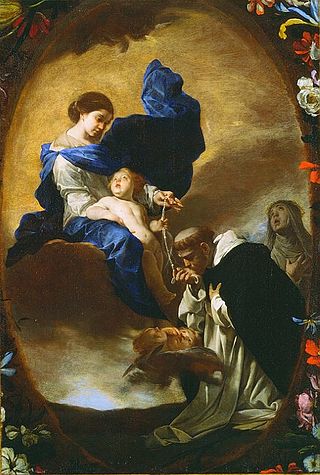
The Rosary, also known as the Dominican Rosary, refers to a set of prayers used primarily in the Catholic Church, and to the physical string of knots or beads used to count the component prayers. When referring to the prayer, the word is usually capitalized ; when referring to the prayer beads as an object, it is written with a lower-case initial letter.
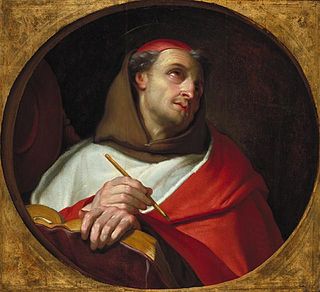
Bonaventure, born Giovanni di Fidanza, was an Italian Catholic Franciscan, bishop, cardinal, scholastic theologian and philosopher.
Middle English Bible translations (1066-1500) covers the age of Middle English, beginning with the Norman conquest and ending about 1500. Aside from Wycliffe's Bible, this was not a fertile time for Bible translation. English literature was limited because French was the preferred language of the elite, and Latin was the preferred literary language in Medieval Western Europe.

Robert Southwell, also Saint Robert Southwell, was an English Roman Catholic priest of the Jesuit Order. He was also a poet, hymnodist, and clandestine missionary in Elizabethan England.

Eucharistic adoration is a Eucharistic devotional practice primarily in Western Catholicism, but also to a lesser extent in certain Lutheran and Anglican traditions, in which the Blessed Sacrament is adored by the faithful. This practice may occur either when the Eucharist is exposed, or when it is not publicly viewable because it is reserved in a place such as a church tabernacle.

Mount Grace Priory is a monastery in the parish of East Harlsey, North Yorkshire, England. Set in woodlands within the North York Moors National Park, it is represented today by the best preserved and most accessible ruins among the nine houses of the Carthusian Order, which existed in England in the Middle Ages and were known as charterhouses.
Francis of Assisi founded three orders and gave each of them a special rule. Here, only the rule of the first order is discussed, i.e., that of the Order of Friars Minor.

John Justus of Landsberg was a German Carthusian monk and ascetical writer.

Concepción Cabrera de Armida was a Mexican Catholic mystic and writer.

Nicholas Love, also known as Nicholas Luff, was first a Benedictine and then a Carthusian monk in medieval England, and became the first prior of Mount Grace charterhouse in Yorkshire. He was the translator and reviser of a popular devotional treatise which was used by the Church authorities to counter the teaching of John Wycliffe. In his later years he convinced Henry V of England to attempt to reform Benedictine monasticism in England, but died before measures could be taken.

Rosary-based prayers are Christian prayers said on a set of rosary beads, among other cords. These prayers recite specific word sequences on different parts of the rosary beads. They may be directed to Jesus Christ, the Virgin Mary or God the Father.
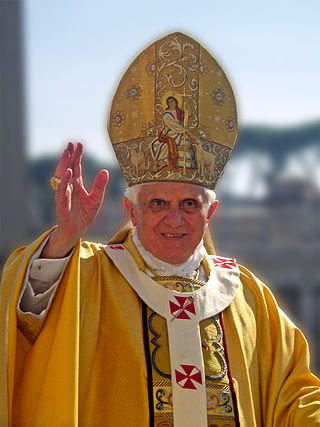
The Pope Benedict XVI bibliography contains a list of works by Pope Benedict XVI.
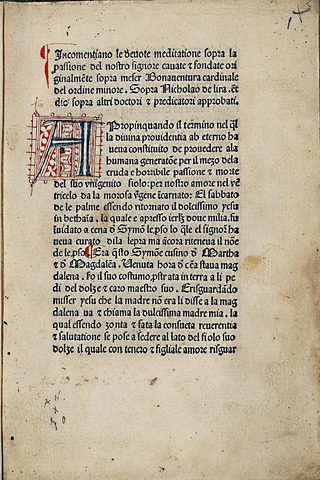
The Meditations on the Life of Christ is a fourteenth-century devotional work, later translated into Middle English by Nicholas Love as The Mirror of the Blessed Life of Jesus Christ.

Pseudo-Bonaventure is the name given to the authors of a number of medieval devotional works which were believed at the time to be the work of Bonaventure: "It would almost seem as if 'Bonaventura' came to be regarded as a convenient label for a certain type of text, rather than an assertion of authorship". Since it is clear a number of actual authors are involved, the term "Pseudo-Bonaventuran" is often used. Many works now have other attributions of authorship which are generally accepted, but the most famous, the Meditations on the Life of Christ, remains usually described only as a work of Pseudo-Bonaventure.
Richard Whitford was a 16th century English Catholic priest known as an author of many devotional works.
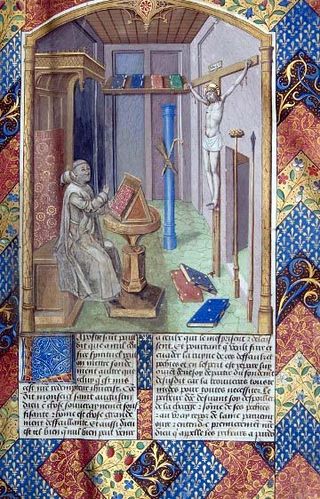
The Vita Christi, also known as the Speculum vitae Christi is the principal work of Ludolph of Saxony, completed in 1374.
Thomas of Hales, also known as Thomas de Hales, was a thirteenth-century English Franciscan friar and ecclesiastical writer of intellectually progressive prose and poetry in three languages: Latin, French, and English. Thomas of Hales was one of very few Franciscan lyricists of the mid to late thirteenth century. His "career is an importantly the day witness of the literary culture of ... mid-thirteenth-century England. Few other writers show hiEngland, and his works put him at the forefront of the movement towards affective piety, vernacular literacy, and textual scholarship based on university methods. His English poem Love Rune is frequently anthologized. He is believed to come from Hales, Gloucestershire. A few works of his survive. One, in Latin, is a life of the Virgin Mary called De vita seu genealogia Beatae Virginis Mariae, which survives in a thirteenth-century copy once in the library of the abbey of St Victor. It draws from the Gospels, Apocrypha, patristic texts, and the visions of Elizabeth of Schönau. This was his most popular work, and while it is not theologically adventurous its spirit and organization reflect ideas and methods then popular in university settings. Its approach to Mary's life falls in line with trends in affective piety.

Affective piety is most commonly described as a style of highly emotional devotion to the humanity of Jesus, particularly in his infancy and his death, and to the joys and sorrows of the Virgin Mary. It was a major influence on many varieties of devotional literature in late-medieval Europe, both in Latin and in the vernaculars. This practice of prayer, reading, and meditation was often cultivated through visualization and concentration on vivid images of scenes from the Bible, Saints' Lives, Virgin Mary, Christ and religious symbols, feeling from the result. These images could be either conjured up in people's minds when they read or heard poetry and other pieces of religious literature, or they could gaze on manuscript illuminations and other pieces of art as they prayed and meditated on the scenes depicted. In either case, this style of affective meditation asked the "viewer" to engage with the scene as if she or he were physically present and to stir up feelings of love, fear, grief, and/or repentance for sin.
"Herr Jesu Christ, wahr Mensch und Gott" is a Lutheran hymn by Paul Eber. It is a hymn for the dying. One of the hymn's tunes, Zahn No. 423, is also used for "Wir danken dir, Herr Jesu Christ".

Horologium Sapientiae was written by the German Dominican Henry Suso between 1328 and 1330. The book belongs to the tradition of Rhineland mystics and German mysticism. It was quickly translated into a range of European languages and it was one of the three most popular European devotional texts of the fourteenth and fifteenth centuries.













